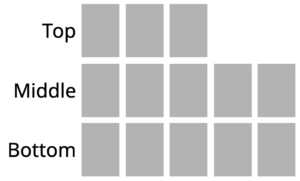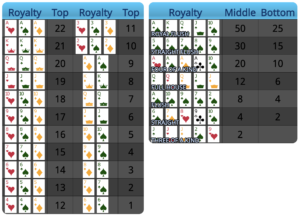For those familiar with Chinese poker, you know players are given 13 cards in the first hand. They then lay those cards out in three rows of 3, 5, and 5 cards. Laid out in front of the player with the two five card rows closest, the goal is that the closet row, known as the back, is stronger than the middle, and the middle is stronger than the front, the 3-card row.
In another major difference, in traditional Chinese poker the back set is upside down so only the player can see what his or her strongest hand is.
In Pineapple Open-face Chinese poker, players are only given five cards in the first hand. All of their cards are placed face up in the three sets (front – 3, middle – 5, and back – 5). They are then given three cards at a time to complete their sets. They set two cards and discard one until the 13 cards are dealt. That means that every player sees 17 cards and 4 are hidden. See the notes from Derric Haynie’s article below to understand why that makes game play more exciting and profitable.

Some notes on game play
In either game, if a player has a pair of Queens or higher in their front set, they enter “fantasyland.” In fantasyland, the player will be given all thirteen cards in a single hand in the next hand, while their opponents are still dealt the standard five, then three.
Fantasyland adds an extra round. Since the hands are scored on a point system, it’s possible to win even if one of your sets isn’t as strong as your opponents. The fact that cards are dealt in a series, rather than all at once, reduces the impact of pure chance on the game. There’s room for a little strategy.
There is a special set of rules for remaining in fantasyland if you’re already in fantasyland.
Each player must ensure that they have the strength of the rows in order, strongest at the back and weakest at the front, so they run the risk of fouling. A player loses points for fouling. As the game is based on points, the fouling player loses 6 points and each non-fouling player gains 6 points.
Points are awarded based on the strength of each set.

Then the game becomes a matter of what player has the most points.

